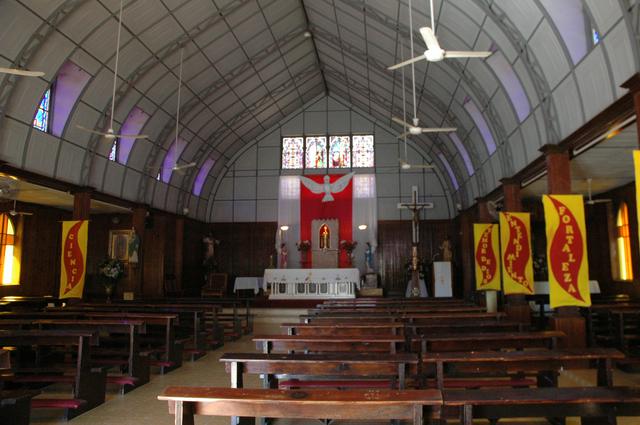Santa Rosalía is a city of about 12,000 people (2010) on the Gulf of California coast of the Baja California Peninsula.
Santa Rosalía has French influence, particularly in its architecture. The French company El Boleo founded the town in 1884 and exploited copper mines there until they closed in 1954. They built houses and installed the metallic Iglesia de Santa Bárbara, which was designed by Gustave Eiffel.

- Iglesia de Santa Bárbara, Álvaro Obregón 20, Centro. A prefabricated iron church that was designed by Alexandre-Gustave Eiffel in 1884, and built in 1887. It was shown at the 1889 Exposition Universelle of Paris, then acquired by the Boleo Mining Company who installed it in Santa Rosalía in late 1897.
- Unlike many other mining sites, the industrial facilities which are in the middle of the town, were never dismantled. Old locomotives, mining equipment and machinery are visible everywhere. The main mining company offices (La dirección) have been converted into an industrial museum.
- Mesa France is a neighbourhood where you can appreciate the French colonial architectural style. The French mining technicians and officials of the company lived here.
Iglesia de Santa Bárbara, Álvaro Obregón 20, Centro. A prefabricated iron church that was designed by Alexandre-Gustave Eiffel in 1884, and built in 1887. It was shown at the 1889 Exposition Universelle of Paris, then acquired by the Boleo Mining Company who installed it in Santa Rosalía in late 1897.
Unlike many other mining sites, the industrial facilities which are in the middle of the town, were never dismantled. Old locomotives, mining equipment and machinery are visible everywhere. The main mining company offices (La dirección) have been converted into an industrial museum.
Mesa France is a neighbourhood where you can appreciate the French colonial architectural style. The French mining technicians and officials of the company lived here.
- El Vizcaíno Biosphere Reserve. It is a UNESCO World Heritage Site, and the largest wildlife refuge in Mexico with a landmass of almost 25,000 km². The Vizcaíno is the habitat of the Baja California pronghorn,cone of the swiftest mammals on Earth, the desert bighorn sheep, Mule deer, and dozens of resident and migratory birds: the ospreys, cormorants, herons, and gulls, and four species of sea turtles. On the coastline and islets there are many marine mammals, such as northern elephant seals, California sea lions, dolphins, and gray whales.
El Vizcaíno Biosphere Reserve. It is a [[UNESCO World Heritage Site]], and the largest wildlife refuge in Mexico with a landmass of almost 25,000 km². The Vizcaíno is the habitat of the Baja California pronghorn,cone of the swiftest mammals on Earth, the desert bighorn sheep, Mule deer, and dozens of resident and migratory birds: the ospreys, cormorants, herons, and gulls, and four species of sea turtles. On the coastline and islets there are many marine mammals, such as northern elephant seals, California sea lions, dolphins, and gray whales.
